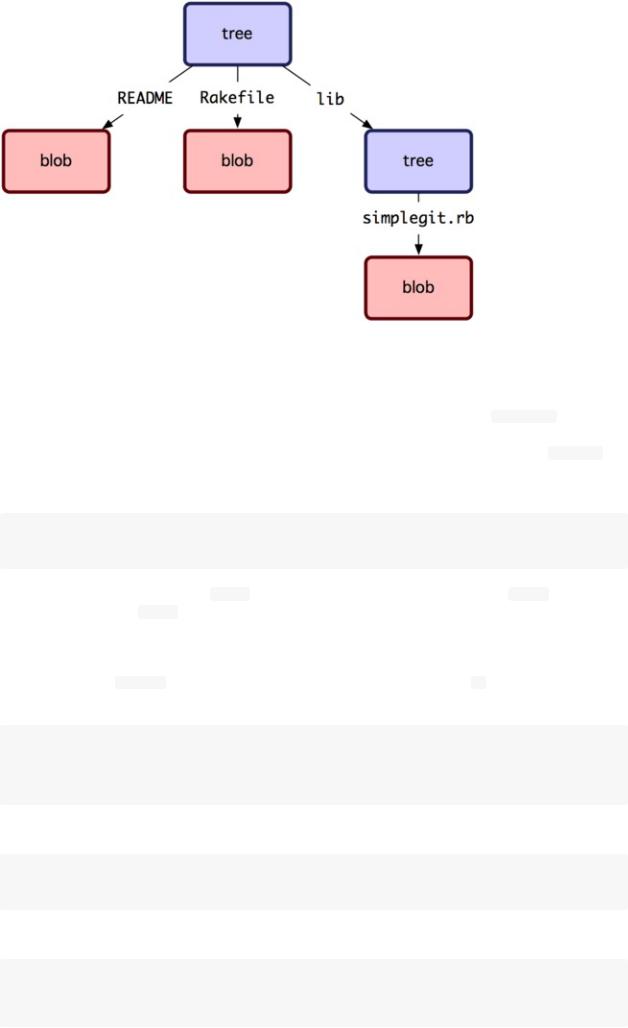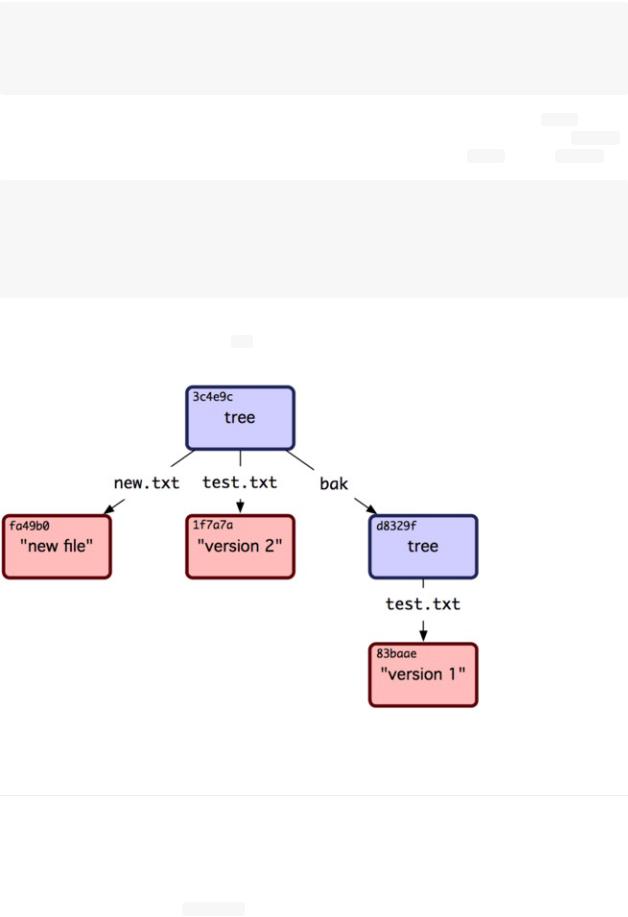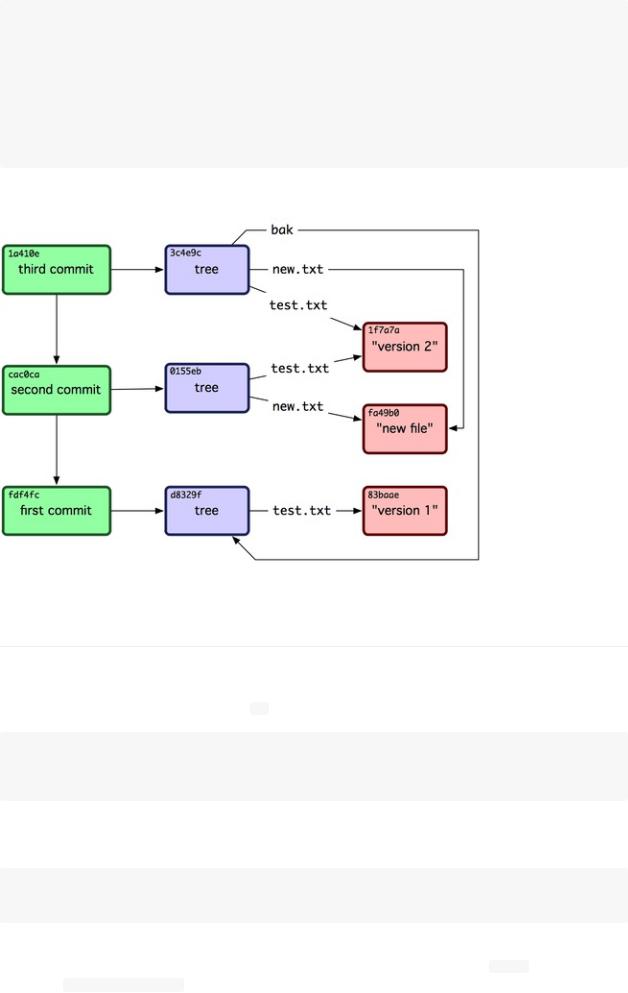
- •Getting Started
- •About Version Control
- •A Short History of Git
- •Git Basics
- •Installing Git
- •First-Time Git Setup
- •Getting Help
- •Summary
- •Git Basics
- •Getting a Git Repository
- •Recording Changes to the Repository
- •Viewing the Commit History
- •Undoing Things
- •Working with Remotes
- •Tagging
- •Tips and Tricks
- •Summary
- •Git Branching
- •What a Branch Is
- •Basic Branching and Merging
- •Branch Management
- •Branching Workflows
- •Remote Branches
- •Rebasing
- •Summary
- •Git on the Server
- •The Protocols
- •Getting Git on a Server
- •Generating Your SSH Public Key
- •Setting Up the Server
- •Public Access
- •GitWeb
- •Gitosis
- •Gitolite
- •Git Daemon
- •Hosted Git
- •Summary
- •Distributed Git
- •Distributed Workflows
- •Contributing to a Project
- •Maintaining a Project
- •Summary
- •Git Tools
- •Revision Selection
- •Interactive Staging
- •Stashing
- •Rewriting History
- •Debugging with Git
- •Submodules
- •Subtree Merging
- •Summary
- •Customizing Git
- •Git Configuration
- •Git Attributes
- •Git Hooks
- •An Example Git-Enforced Policy
- •Summary
- •Git and Other Systems
- •Git and Subversion
- •Migrating to Git
- •Summary
- •Git Internals
- •Plumbing and Porcelain
- •Git Objects
- •Git References
- •Packfiles
- •The Refspec
- •Transfer Protocols
- •Maintenance and Data Recovery
- •Summary

Git Internals
You may have skipped to this chapter from a previous chapter, or you may have gotten here after reading the rest of the book — in either case, this is where you’ll go over the inner workings and implementation of Git. I found that learning this information was fundamentally important to understanding how useful and powerful Git is, but others have argued to me that it can be confusing and unnecessarily complex for beginners. Thus, I’ve made this discussion the last chapter in the book so you could read it early or later in your learning process. I leave it up to you to decide.
Now that you’re here, let’s get started. First, if it isn’t yet clear, Git is fundamentally a content-addressable filesystem with a VCS user interface written on top of it. You’ll learn more about what this means in a bit.
In the early days of Git (mostly pre 1.5), the user interface was much more complex because it emphasized this filesystem rather than a polished VCS. In the last few years, the UI has been refined until it’s as clean and easy to use as any system out there; but often, the stereotype lingers about the early Git UI that was complex and difficult to learn.
The content-addressable filesystem layer is amazingly cool, so I’ll cover that first in this chapter; then, you’ll learn about the transport mechanisms and the repository maintenance tasks that you may eventually have to deal with.

Plumbing and Porcelain
This book covers how to use Git with 30 or so verbs such as checkout , branch , remote , and so on. But because Git was initially a toolkit for a VCS rather than a full user-friendly VCS, it has a bunch of verbs that do low-level work and were designed to be chained together UNIX style or called from scripts. These commands are generally referred to as "plumbing" commands, and the more user-friendly commands are called "porcelain" commands.
The book’s first eight chapters deal almost exclusively with porcelain commands. But in this chapter, you’ll be dealing mostly with the lower-level plumbing commands, because they give you access to the inner workings of Git and help demonstrate how and why Git does what it does. These commands aren’t meant to be used manually on the command line, but rather to be used as building blocks for new tools and custom scripts.
When you run git init in a new or existing directory, Git creates the .git directory, which is where almost everything that Git stores and manipulates is located. If you want to back up or clone your repository, copying this single directory elsewhere gives you nearly everything you need. This entire chapter basically deals with the stuff in this directory. Here’s what it looks like:
$ ls HEAD branches/ config
description hooks/ index
info/
objects/
refs/
You may see some other files in there, but this is a fresh git init repository — it’s what you see by default. The branches directory isn’t used by newer Git versions, and the description file is only used by the GitWeb program, so don’t worry about those. The config file contains your project-specific configuration options, and the info directory keeps a global exclude file for ignored patterns that you don’t want to track in a .gitignore file. The hooks directory contains your clientor server-side hook scripts, which are discussed in detail in Chapter 7.
This leaves four important entries: the HEAD and index files and the objects and refs directories. These are the core parts of Git. The objects directory stores all the content for your database, the refs directory stores pointers into commit objects in that data (branches), the HEAD file points to the branch you currently have checked out, and the index file is where Git stores your staging area information. You’ll now look at each of these sections in detail to see how Git operates.

Git Objects
Git is a content-addressable filesystem. Great. What does that mean? It means that at the core of Git is a simple key-value data store. You can insert any kind of content into it, and it will give you back a key that you can use to retrieve the content again at any time. To demonstrate, you can use the plumbing command hash-object , which takes some data, stores it in your .git directory, and gives you back the key the data is stored as. First, you initialize a new Git repository and verify that there is nothing in the objects directory:
$ mkdir test $ cd test
$ git init
Initialized empty Git repository in /tmp/test/.git/ $ find .git/objects
.git/objects
.git/objects/info
.git/objects/pack
$ find .git/objects -type f
$
Git has initialized the objects directory and created pack and info subdirectories in it, but there are no regular files. Now,
store some text in your Git database:
$ echo 'test content' | git hash-object -w --stdin d670460b4b4aece5915caf5c68d12f560a9fe3e4
The -w tells hash-object to store the object; otherwise, the command simply tells you what the key would be. --stdin tells the command to read the content from stdin; if you don’t specify this, hash-object expects the path to a file. The output from the command is a 40-character checksum hash. This is the SHA-1 hash — a checksum of the content you’re storing plus a header, which you’ll learn about in a bit. Now you can see how Git has stored your data:
$ find .git/objects -type f
.git/objects/d6/70460b4b4aece5915caf5c68d12f560a9fe3e4
You can see a file in the objects directory. This is how Git stores the content initially — as a single file per piece of content, named with the SHA-1 checksum of the content and its header. The subdirectory is named with the first 2 characters of the SHA, and the filename is the remaining 38 characters.
You can pull the content back out of Git with the cat-file inspecting Git objects. Passing -p to it instructs the for you:
command. This command is sort of a Swiss army knife for command to figure out the type of content and display it nicely
$ git cat-file -p d670460b4b4aece5915caf5c68d12f560a9fe3e4 test content
Now, you can add content to Git and pull it back out again. You can also do this with content in files. For example, you can do some simple version control on a file. First, create a new file and save its contents in your database:
$ echo 'version 1' > test.txt $ git hash-object -w test.txt
83baae61804e65cc73a7201a7252750c76066a30
Then, write some new content to the file, and save it again:

$ echo 'version 2' > test.txt $ git hash-object -w test.txt
1f7a7a472abf3dd9643fd615f6da379c4acb3e3a
Your database contains the two new versions of the file as well as the first content you stored there:
$ find .git/objects -type f
.git/objects/1f/7a7a472abf3dd9643fd615f6da379c4acb3e3a
.git/objects/83/baae61804e65cc73a7201a7252750c76066a30
.git/objects/d6/70460b4b4aece5915caf5c68d12f560a9fe3e4
Now you can revert the file back to the first version
$ git cat-file -p 83baae61804e65cc73a7201a7252750c76066a30 > test.txt $ cat test.txt
version 1
or the second version:
$ git cat-file -p 1f7a7a472abf3dd9643fd615f6da379c4acb3e3a > test.txt $ cat test.txt
version 2
But remembering the SHA-1 key for each version of your file isn’t practical; plus, you aren’t storing the filename in your system — just the content. This object type is called a blob. You can have Git tell you the object type of any object in Git, given its SHA-1 key, with cat-file -t :
$ git cat-file -t 1f7a7a472abf3dd9643fd615f6da379c4acb3e3a blob
Tree Objects
The next type you’ll look at is the tree object, which solves the problem of storing the filename and also allows you to store a group of files together. Git stores content in a manner similar to a UNIX filesystem, but a bit simplified. All the content is stored as tree and blob objects, with trees corresponding to UNIX directory entries and blobs corresponding more or less to inodes or file contents. A single tree object contains one or more tree entries, each of which contains a SHA-1 pointer to a blob or subtree with its associated mode, type, and filename. For example, the most recent tree in the simplegit project may look something like this:
$ git cat-file -p master^{tree} |
|
100644 blob a906cb2a4a904a152e80877d4088654daad0c859 |
README |
100644 blob 8f94139338f9404f26296befa88755fc2598c289 |
Rakefile |
040000 tree 99f1a6d12cb4b6f19c8655fca46c3ecf317074e0 |
lib |
The master^{tree} syntax specifies the tree object that is pointed to by the last commit on your master branch. Notice that the lib subdirectory isn’t a blob but a pointer to another tree:
$ git cat-file -p 99f1a6d12cb4b6f19c8655fca46c3ecf317074e0 |
|
100644 blob 47c6340d6459e05787f644c2447d2595f5d3a54b |
simplegit.rb |
Conceptually, the data that Git is storing is something like Figure 9-1.

Figure 9-1. Simple version of the Git data model.
You can create your own tree. Git normally creates a tree by taking the state of your staging area or index and writing a tree object from it. So, to create a tree object, you first have to set up an index by staging some files. To create an index with a single entry — the first version of your test.txt file — you can use the plumbing command update-index . You use this command to artificially add the earlier version of the test.txt file to a new staging area. You must pass it the  option because the file doesn’t yet exist in your staging area (you don’t even have a staging area set up yet) and --cacheinfo because the file you’re adding isn’t in your directory but is in your database. Then, you specify the mode, SHA-1, and filename:
option because the file doesn’t yet exist in your staging area (you don’t even have a staging area set up yet) and --cacheinfo because the file you’re adding isn’t in your directory but is in your database. Then, you specify the mode, SHA-1, and filename:
$ git update-index --add --cacheinfo 100644 \ 83baae61804e65cc73a7201a7252750c76066a30 test.txt
In this case, you’re specifying a mode of 100644 , which means it’s a normal file. Other options are 100755 , which means it’s an executable file; and 120000 , which specifies a symbolic link. The mode is taken from normal UNIX modes but is much less flexible — these three modes are the only ones that are valid for files (blobs) in Git (although other modes are used for directories and submodules).
Now, you can use the write-tree command to write the staging area out to a tree object. No -w option is needed — calling  automatically creates a tree object from the state of the index if that tree doesn’t yet exist:
automatically creates a tree object from the state of the index if that tree doesn’t yet exist:
$ git write-tree |
|
d8329fc1cc938780ffdd9f94e0d364e0ea74f579 |
|
$ git cat-file -p d8329fc1cc938780ffdd9f94e0d364e0ea74f579 |
|
100644 blob 83baae61804e65cc73a7201a7252750c76066a30 |
test.txt |
You can also verify that this is a tree object:
$ git cat-file -t d8329fc1cc938780ffdd9f94e0d364e0ea74f579 tree
You’ll now create a new tree with the second version of test.txt and a new file as well:
$ echo 'new file' > new.txt $ git update-index test.txt
$ git update-index --add new.txt

Your staging area now has the new version of test.txt as well as the new file new.txt. Write out that tree (recording the state of the staging area or index to a tree object) and see what it looks like:
$ git write-tree |
|
0155eb4229851634a0f03eb265b69f5a2d56f341 |
|
$ git cat-file -p 0155eb4229851634a0f03eb265b69f5a2d56f341 |
|
100644 blob fa49b077972391ad58037050f2a75f74e3671e92 |
new.txt |
100644 blob 1f7a7a472abf3dd9643fd615f6da379c4acb3e3a |
test.txt |
Notice that this tree has both file entries and also that the test.txt SHA is the "version 2" SHA from earlier ( 1f7a7a ). Just for
fun, you’ll add the first tree as a subdirectory into this one. You can read trees into your staging area by calling read-tree . In this case, you can read an existing tree into your staging area as a subtree by using the --prefix option to read-tree :
$ git read-tree --prefix=bak d8329fc1cc938780ffdd9f94e0d364e0ea74f579 $ git write-tree
3c4e9cd789d88d8d89c1073707c3585e41b0e614
$ git cat-file -p 3c4e9cd789d88d8d89c1073707c3585e41b0e614
040000 tree d8329fc1cc938780ffdd9f94e0d364e0ea74f579 |
bak |
100644 blob fa49b077972391ad58037050f2a75f74e3671e92 |
new.txt |
100644 blob 1f7a7a472abf3dd9643fd615f6da379c4acb3e3a |
test.txt |
If you created a working directory from the new tree you just wrote, you would get the two files in the top level of the working directory and a subdirectory named bak that contained the first version of the test.txt file. You can think of the data that Git contains for these structures as being like Figure 9-2.
Figure 9-2. The content structure of your current Git data.
Commit Objects
You have three trees that specify the different snapshots of your project that you want to track, but the earlier problem remains: you must remember all three SHA-1 values in order to recall the snapshots. You also don’t have any information about who saved the snapshots, when they were saved, or why they were saved. This is the basic information that the commit object stores for you.
To create a commit object, you call commit-tree and specify a single tree SHA-1 and which commit objects, if any, directly preceded it. Start with the first tree you wrote:

$ echo 'first commit' | git commit-tree d8329f fdf4fc3344e67ab068f836878b6c4951e3b15f3d
Now you can look at your new commit object with cat-file :
$ git cat-file -p fdf4fc3
tree d8329fc1cc938780ffdd9f94e0d364e0ea74f579
author Scott Chacon <schacon@gmail.com> 1243040974 -0700 committer Scott Chacon <schacon@gmail.com> 1243040974 -0700
first commit
The format for a commit object is simple: it specifies the top-level tree for the snapshot of the project at that point; the author/committer information pulled from your user.name and user.email configuration settings, with the current timestamp; a blank line, and then the commit message.
Next, you’ll write the other two commit objects, each referencing the commit that came directly before it:
$ echo 'second commit' | git commit-tree 0155eb -p fdf4fc3 cac0cab538b970a37ea1e769cbbde608743bc96d
$ echo 'third commit' | git commit-tree 3c4e9c -p cac0cab 1a410efbd13591db07496601ebc7a059dd55cfe9
Each of the three commit objects points to one of the three snapshot trees you created. Oddly enough, you have a real Git history now that you can view with the  command, if you run it on the last commit SHA-1:
command, if you run it on the last commit SHA-1:
$ git log --stat 1a410e
commit 1a410efbd13591db07496601ebc7a059dd55cfe9 Author: Scott Chacon <schacon@gmail.com>
Date: Fri May 22 18:15:24 2009 -0700
third commit
bak/test.txt | 1 +
1 files changed, 1 insertions(+), 0 deletions(-)
commit cac0cab538b970a37ea1e769cbbde608743bc96d Author: Scott Chacon <schacon@gmail.com>
Date: Fri May 22 18:14:29 2009 -0700
second commit
new.txt |
| |
1 + |
test.txt |
| |
2 +- |
2 files changed, 2 insertions(+), 1 deletions(-)
commit fdf4fc3344e67ab068f836878b6c4951e3b15f3d Author: Scott Chacon <schacon@gmail.com>
Date: Fri May 22 18:09:34 2009 -0700
first commit
test.txt | 1 +
1 files changed, 1 insertions(+), 0 deletions(-)
Amazing. You’ve just done the low-level operations to build up a Git history without using any of the front ends. This is essentially what Git does when you run the git add and git commit commands — it stores blobs for the files that have changed, updates the index, writes out trees, and writes commit objects that reference the top-level trees and the commits that came immediately before them. These three main Git objects — the blob, the tree, and the commit — are initially stored as separate files in your .git/objects directory. Here are all the objects in the example directory now, commented with what they store:

$ find .git/objects -type f
.git/objects/01/55eb4229851634a0f03eb265b69f5a2d56f341 # tree 2
.git/objects/1a/410efbd13591db07496601ebc7a059dd55cfe9 # commit 3
.git/objects/1f/7a7a472abf3dd9643fd615f6da379c4acb3e3a # test.txt v2
.git/objects/3c/4e9cd789d88d8d89c1073707c3585e41b0e614 # tree 3
.git/objects/83/baae61804e65cc73a7201a7252750c76066a30 # test.txt v1
.git/objects/ca/c0cab538b970a37ea1e769cbbde608743bc96d # commit 2
.git/objects/d6/70460b4b4aece5915caf5c68d12f560a9fe3e4 # 'test content'
.git/objects/d8/329fc1cc938780ffdd9f94e0d364e0ea74f579 # tree 1
.git/objects/fa/49b077972391ad58037050f2a75f74e3671e92 # new.txt
.git/objects/fd/f4fc3344e67ab068f836878b6c4951e3b15f3d # commit 1
If you follow all the internal pointers, you get an object graph something like Figure 9-3.
Figure 9-3. All the objects in your Git directory.
Object Storage
I mentioned earlier that a header is stored with the content. Let’s take a minute to look at how Git stores its objects. You’ll see how to store a blob object — in this case, the string "what is up, doc?" — interactively in the Ruby scripting language. You can start up interactive Ruby mode with the irb command:
$ irb
>> content = "what is up, doc?" => "what is up, doc?"
Git constructs a header that starts with the type of the object, in this case a blob. Then, it adds a space followed by the size of the content and finally a null byte:
>> header = "blob #{content.length}\0" => "blob 16\000"
Git concatenates the header and the original content and then calculates the SHA-1 checksum of that new content. You can calculate the SHA-1 value of a string in Ruby by including the SHA1 digest library with the require command and then calling Digest::SHA1.hexdigest() with the string:

>>store = header + content => "blob 16\000what is up, doc?"
>>require 'digest/sha1'
=> true
>> sha1 = Digest::SHA1.hexdigest(store)
=> "bd9dbf5aae1a3862dd1526723246b20206e5fc37"
Git compresses the new content with zlib, which you can do in Ruby with the zlib library. First, you need to require the library and then run Zlib::Deflate.deflate() on the content:
>>require 'zlib' => true
>>zlib_content = Zlib::Deflate.deflate(store)
=> "x\234K\312\311OR04c(\317H,Q\310,V(-\320QH\311O\266\a\000_\034\a\235"
Finally, you’ll write your zlib-deflated content to an object on disk. You’ll determine the path of the object you want to write out (the first two characters of the SHA-1 value being the subdirectory name, and the last 38 characters being the filename within that directory). In Ruby, you can use the FileUtils.mkdir_p() function to create the subdirectory if it doesn’t exist. Then, open the file with File.open() and write out the previously zlib-compressed content to the file with a write() call on the resulting file handle:
>> path = '.git/objects/' + sha1[0,2] + '/' + sha1[2,38]
=> ".git/objects/bd/9dbf5aae1a3862dd1526723246b20206e5fc37"
>>require 'fileutils' => true
>>FileUtils.mkdir_p(File.dirname(path)) => ".git/objects/bd"
>>File.open(path, 'w') { |f| f.write zlib_content } => 32
That’s it — you’ve created a valid Git blob object. All Git objects are stored the same way, just with different types — instead of the string blob, the header will begin with commit or tree. Also, although the blob content can be nearly anything, the commit and tree content are very specifically formatted.
